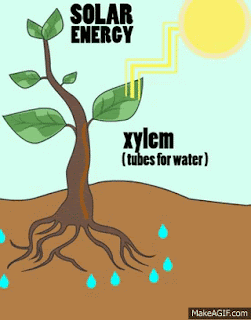HOW PLANTS LIVE
What do plants need to grow?
Plants only grow in places where they can get what they need to survive. The place where a plant lives is called its habitat.
SPANISH: Las plantas solo crecen en lugares donde pueden obtener lo que necesitan para sobrevivir. El lugar dónde vive una planta es su hábitat.
Unlike animals, plants make their own food. This process is called photosynthesis. Plants need sunlight, water, mineral salts and carbon dioxide to carry out photosynthesis.
SPANISH: Al contrario que los animales, las plantas fabrican su propia comida. Este proceso se llama fotosíntesis. Las plantas necesitan luz solar, agua, sales minerales y dióxido de carbono para llevar a cabo la fotosíntesis.
Plant sensivity.
Like animals, plants respond to changes in the environment. However, plants respond differently to animals because they do not have sense organs. Most of their respnses are movements related to growth.
SPANISH: Al igual que los animales, las plantes responden a los cambios del entorno. Sin embargo, las plantas responde de manera diferente a los animales debido a que las plantas no tienen órganos de los sentidos. La mayoría de sus respuestas están relacionadas con el crecimiento.
- The roots grow downwards, in search of humidity. Las raíces crecen hacia abajo, en busca de humedad.
- The stem and the leaves grow towards light. If the plant receives sunlight from one side, the stem and the leaves grow in that direction. El tallo y las hojas crecen hacia la luz Si la planta recibe luz solar de un lado, el tallo y las hojas crecen en esa dirección.
 |
| Phototropism |
Some plants are capable of rapid movement. For example, the mimosa plant closes its leaves when it is touched.
SÀNISH: Algunas plantas son capaces de realizar movimientos reflejos. Por ejemplo, la mimosa cierra sus hojas cuando es tocada.
 |
| Mimosa |
The life cycle of plants.
The life cycle of a plant includes the different stages of its life. Life cycles are not the same for all plants. There are two main groups of plants: annual and perennial.
SPANISH: El ciclo de vida de una planta incluye las diferentes etapas de su vida. El ciclo vital no es el mismo en todas plantas. Hay dos grupos principales de plantes: anuales y perennes.
Annual plants: These plants complete their lyfe cycle in one year. They are born, grow, reproduce in spring and they die in the summer. Annual plants disappear, but their seeds remain in the soil, and new plants grow again each spring. Poppies, sunflowers and cabbages are annual plants.
SPANISH: Plantas anuales. Estas plantas completan su ciclo vital en un año. Nace, crecen y se reproducen en primavera pero mueren en verano. Las plantas anuales desaparecen, pero sus semillas permanecen en la tierra, y nuevas plantas crecen de nuevo cada primavera. Las amapolas, el girasol y la col son plantas anuales.
 |
| Poppies |
 |
| Sunflowers |
 |
| Cabbage |
Perennial plants: These plants have got a long life cycle. Some trees, such as olive trees and yews, live for thousands of years. Their trunks and roots grow throughout their life cycle.
SPANISH: Plantas perennes. Estas plantas tienen una larga vida. Algunos árboles , como el olivo y los tejos, viven cientos de años. Sus troncos y raíces crecen a lo largo de su vida.
 |
| Olive tree |
 |
| Yew |
There are two types of perennial plants: perennial grasses and trees and bushes.
SPANISH: Hay dos tipos de plantas perennes: las hierbas perennes y los árboles y arbustos.
CONCLUSION/OUTLINES (ESTUDIAR)
WORDLIST:
- Plants: plantas.
- Habitat: hábitat.
- Photosynthesis: fotosíntesis.
- Grow: crecer.
- Sunlight: luz solar.
- Water: agua.
- Mineral salts: sales minerales.
- Carbon dioxide: dióxido de carbono.
- Growth: crecimiento.
- Humidity: humedad.
- Life cycle: ciclo de vida/ciclo vital.
- Annual plants: plantas anuales.
- Spring: primavera.
- Summer: verano.
- Poppies: amapolas.
- Sunflowers: girasoles.
- Cabbges: repollos, coles.
- Soil: tierra.
- Olive tree: olivo.
- Yew: tejo.
EXPERIMENTO FOTOTROPISMO







